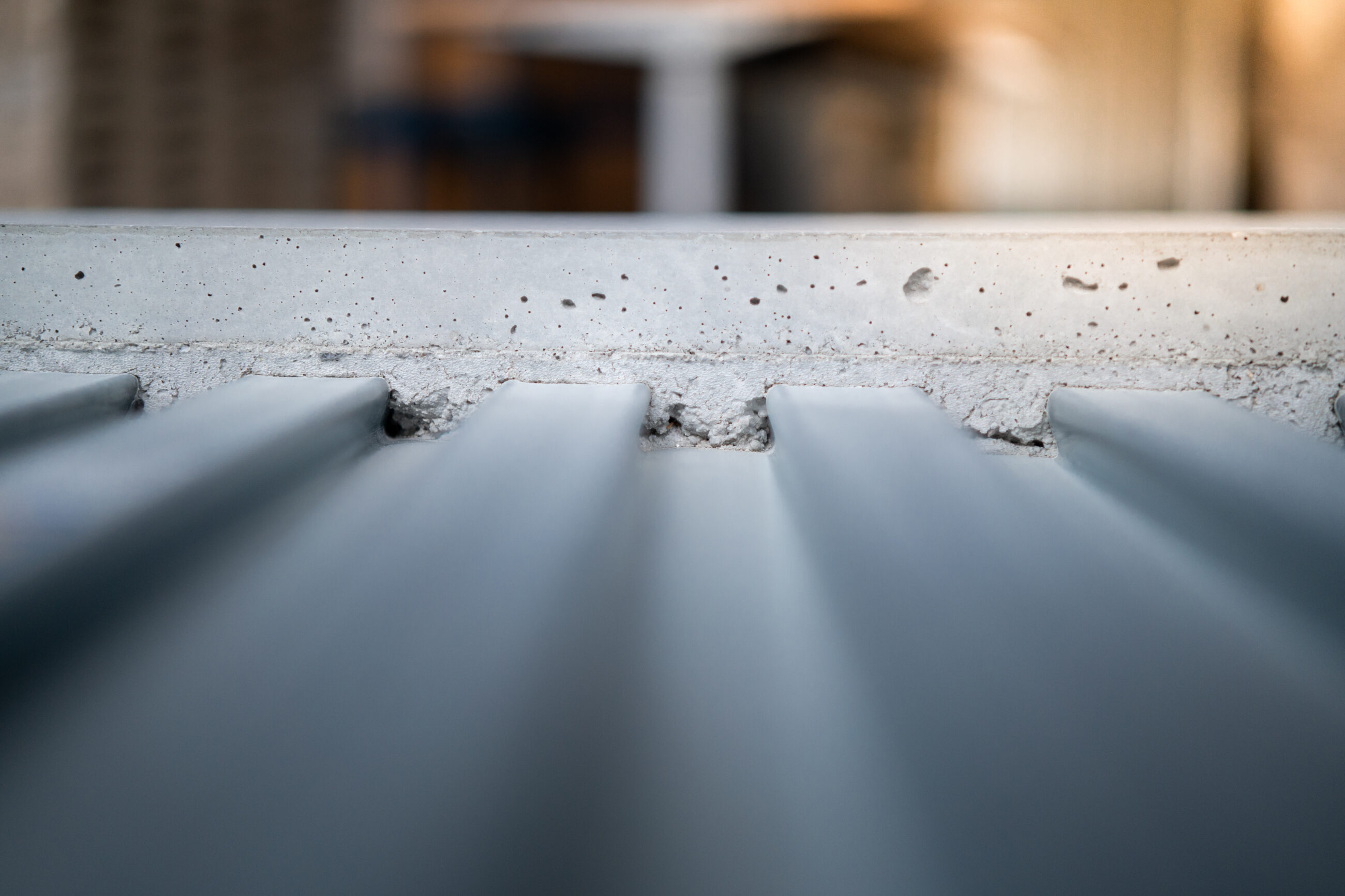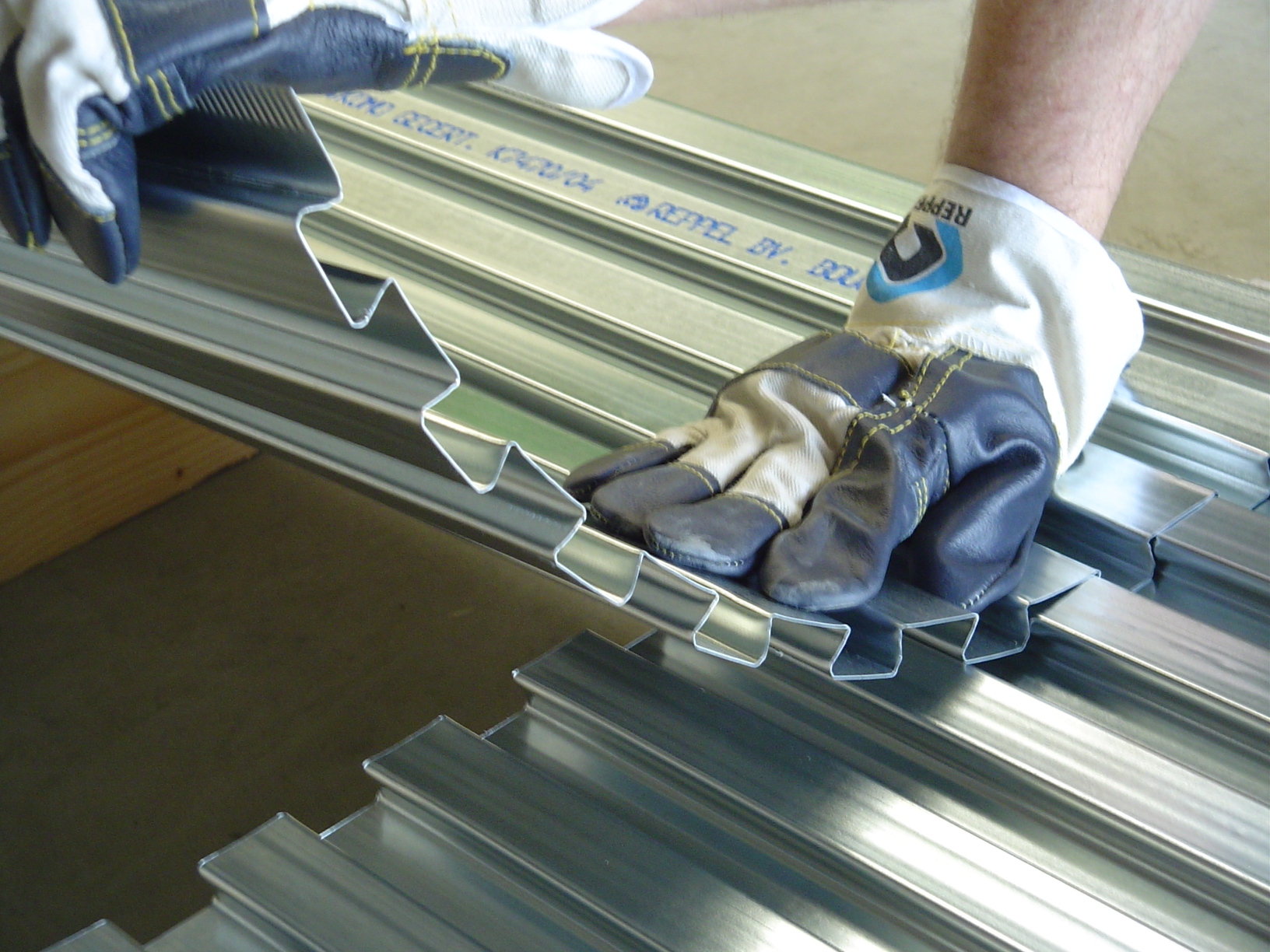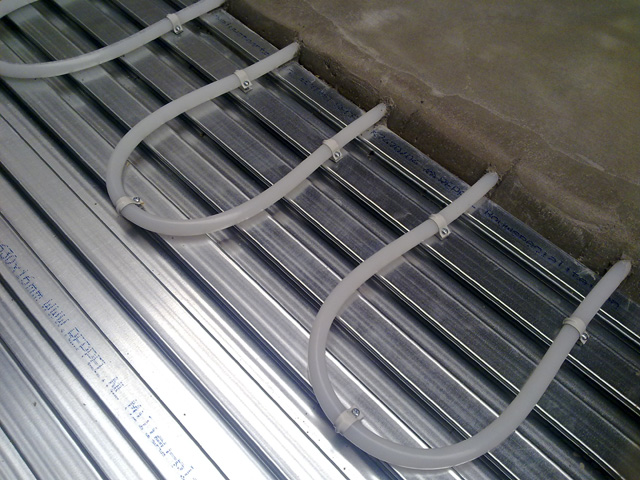Installation instructions
LEWIS Dovetailed sheeting

-
Low self weight (from approx. 45 kg/m2)
-
High permissible load
-
Floor thickness from 36 mm
-
Easy to install
-
Sound insulating
-
Up to 120 minutes fire resistance
Before you start - Safety
When laying LEWIS floors, always pay attention to safety. Despite the ribbed side flanges, the LEWIS Dovetailed sheets have sharp edges and corners. Therefore, wear protective gloves and safety shoes. Ensure the LEWIS Dovetailed sheeting are always stable on the substructure.
Keep in mind that the sheets may be deformed if they are exposed to excessive loads.
Have the supporting structure (beam, walls, foundation) professionally checked to ensure it has sufficient strength to support the new LEWIS floor!
Need help?
We are happy to help you with questions about the installation of the LEWIS Dovetailed sheets
Ask your questionLaying and overlapping the LEWIS Dovetailed sheets
The LEWIS sheets must be laid at right angles across the timber joisting, even if directly laid on the floor boards.
Standard laying procedure is a first row of sheets lengthwise, the first sheet with the blue print below, the following with the print on top. The adjacent row starts with a sheet with the blue print on top, etc. The sheets can also be laid “stretcher bonding”.

Crosscut overlaps
≥ 50 mm overlap if completely supported and nailed onto the existing floor. ≥ 100 mm overlap if laid on the timber joists or on resilient strips.
Crosscut overlaps are made by having the sheets “click” into each other alternately (one with the blue print below and one with the print up) over a length of 50 – 100 mm. Crosscut overlaps can be adjusted by sliding the sheets together or apart a bit more.
If LEWIS mineral wool resilient strips are used, first click the sheets together on a hard (not springy) surface!
Lengthwise overlaps
The overlap of the longitudinal side is created by sliding the bottom and top side flanges of the plates over each other up to the first profile. The working width of the LEWIS Dovetailed sheeting is then approx. 580 mm.
A row length of LEWIS Dovetailed sheeting can easily be slid over or under the side flanges of the previous row of sheets.
Connections
The LEWIS floor must be kept free of approx. 10 mm from the rising work (walls, penetrations, etc.) by means of edge strips. With a sound-insulating (floating) LEWIS floor, LEWIS sound-insulating mineral wool strips (20 mm) must be applied.
Shortening and cut-outs
The LEWIS Dovetailed sheets can be easily cut to size, both in width and length, with an angle grinder with a steel cutting disc. Cut-outs can be made with the same tool or with a jigsaw.
-
Crosscut overlap
-
Lengthwise overlap
Fixing
Timber joists
The LEWIS sheets should be nailed into the upper flange where the sheets overlap on new timber joists and floor boards.
This can be done with regular wire nails or self-tapping screws. On old timber joists or floor boards, the LEWIS sheets can be nailed into the lower flange.
Steel beams
LEWIS sheets can be secured to steel beams with nail guns, dowels or pop rivets.
When a moment-tight connection is achieved by attachment with dowels or a nail gun, additional shrinkage reinforcement is needed.
Concrete beams
On concrete beams and masonry supports the LEWIS sheets must be laid in cement mortar and temporary weighted until the mortar has set. Self-drilling screws can be used on aerated concrete blocks.
Sound-insulating floor
With a sound-insulating (floating) LEWIS floor or when using underfloor heating, the LEWIS sheets must never be permanently fixed to the substructure!
Temporary fixation
If the LEWIS sheets are loose on the substructure (e.g. floating floor / floor with underfloor heating), the LEWIS sheet must be temporarily fixed at the floor edges with squeezing slats or with wooden wedge-shaped blocks (fixed by self-drilling screws ), to prevent the floor from rising in the corners and along the edges during the drying of the mortar.
Interconnected (wood-concrete) LEWIS floors
With a interconnected LEWIS floor, a hardened LEWIS screw nail is applied to the joists into each lower flange of the LEWIS sheets. After fixing, the head of the nail should be at the same level as the top of the LEWIS sheeting.
In order to prevent initial deflection of the timber supporting structure while applying the mortar, the load bearing timber joist must be underpinned temporarily.
After the mortar has hardened sufficiently, the pins can be removed.
Floating sound resistant LEWIS floors
LEWIS mineral wool resilient strips, thickness 25mm, width 100 mm (or the full width of the beam +10 mm), to be applied directly to the joists (min. 500 mm centres).
The strips can be laid onto the floor boards (over the joists!) or directly on the joists.
If the centre-to-centre distance exceeds 800 mm and/or the load applied exceeds 2.5 kN/m2, LEWIS CDM rubber granulate or LEWIS CDM PF resilient strips should be used.
Crosscut overlaps of the LEWIS sheeting, that are approx. 100 mm wide, must always be made over a supporting resilient strip.
Keep a bit of space between the sheets and the perimeter, by using mineral wool edge strips.
Contact bridges for central heating ducts, pipes, etc. must be avoided by insulating with the same mineral wool.


Waterproof LEWIS flooer
It is preferable to remove the wooden floor sections or otherwise install ventilation openings.
On the LEWIS concrete floor, a watertight connection must be made with a water resistant tape (sealing tape + sealing paste) at the wall-floor connection, shower drain, drainage channel (eg Easy Drain) and any penetrations.

LEWIS floors with underfloor heating
Keep a 10 mm space at minimum between the perimeter of the floor and the vertical walls by using LEWIS edging strips, for example.
The underfloor heating pipes can be attached to the top flange of the LEWIS sheeting using tape, (clamp) saddles or a plastic clip rail system, depending on the installation.
Install the underfloor heating pipes at right angles to the top flange of the LEWIS sheeting as much as possible. Do not attach the LEWIS sheets themselves to the wooden subfloor!

Applying mortar
When installing the LEWIS sheeting, bear in mind that this initially serves only to support the mortar and will only start functioning as reinforcement after the concrete mortar has set.
Therefore it is not possible to lay a ceramic or natural stone floor finishing in the mortar directly. Terrazzo (granite) floors must always be applied to a smooth, finished concrete substrate.
LEWIS sheeting can be finished with a (lightweight) fine gravel concrete (C20/25) or a self-levelling mortar (C20/F4). In specific applications it is possible to use a cementitious floor mortar (C20/F4). Please contact REPPEL BV for further advice.

Recommended thickness of concrete
| standard floor for housing: | |
|---|---|
| 16 mm + min. 20 mm | = 36 mm |
| standard floor for commercial construction: | |
| 16 mm + 34 mm | = 50 mm |
| soundproof floor: | |
| 16 mm + 59 mm | = 75 mm |
| interconnected floor: | |
| 16 mm + 34 mm | = 50 mm |
| floor heating: | |
| 16 mm + 20* mm + 20/25 mm | = 56/61 mm |
Note: Profile height of LEWIS sheet 16 mm + concrete cover layer = total floor thickness.
* to accommodate diameter of heating ducts.
Specifications
Fine gravel concrete mix can be composed as follows (volume parts):
– 1 portland cement
– 2 1/2 concrete sand (0-4 mm)
– 1 fine gravel (2-8 mm)
Level the slightly more than moist mortar at right angles to the dovetail plate and compact well with the trowel.
We recommend using factory premixed fine gravel concrete.
Formula required amount of mortar:
LEWIS floor thickness – 8 = ltrs/m2
To prevent shrinkage cracking as much as possible, allow the fine gravel concrete mortar applied to the LEWIS Dovetailed sheeting to dry/cure gradually. Temporarily cover the finished mortar floor with polyethylene foil and do not load the floor until it has hardened sufficiently!
Temporary propping
At a center to center distance larger than 1200 mm (floor thickness 50 mm) or 1000 mm (floor thickness 75 mm) it is necessary to temporarily prop up the LEWIS dovetailed sheet. One row of props per span is sufficient.

Service and quality are key concepts with us.
Contact us
